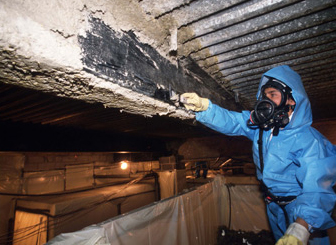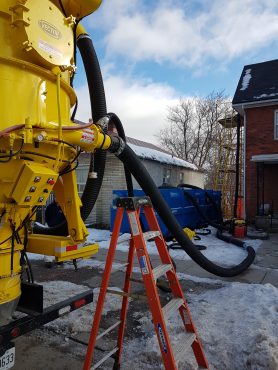
John Bleasby
B.C. considers a full asbestos abatement “licensing scheme” for workers and businesses
Canadian ContractorProvince’s move comes after new federal bans effective January 2019
Asbestos has been recognized as a silent killer for years, and recent new federal regulations that took effective January 2019 banning asbestos appear to have energized the province of British Columbia to react. The province is considering licensing and regulations that go beyond what is currently the standard elsewhere in Canada. If adopted, some of the steps would have a ripple effect on the residential renovation industry across the Canada as well.
B.C. considers going beyond current regulatory standards
Various Occupational Health and Safety regulations dealing with asbestos abatement, removal and disposal are already in force across the country. What makes B.C.’s considerations different is that they go beyond setting provincially recognized standards and programs for the training and certification of asbestos abatement workers to include the possible licensing of individual companies as well.
Asbestos abatement and removal needs financial incentives in order to be effective
The Victoria Residential Builders Association (VRBA) in a recent media release largely welcomes the impact study currently underway in B.C. as overdue. “There are no regulations for removal of asbestos for homeowners, exposing families to risk,” they said. The VRBA also is advocating for an incentive program for asbestos removal that would encourage homeowners to have the substance removed by qualified individuals rather than seeing the issue left either unresolved or handled in an unsafe manner.
“For many years the Victoria Residential Builders Association has called for a tax credit or rebate to encourage homeowners to use professionals,” VRBA Executive Director Casey Edge told Canadian Contractor. “It’s not credible for government to be warning of the dangers of asbestos and add more regulations and costs for its removal without an incentive program for homeowners. Otherwise, as costs increase, many consumers may continue avoiding safe abatement practices.”
Government needs to step and take responsibility for their earlier actions
Edge feels strongly that the asbestos issue was created by government in the first place. He cites the Canadian Home Insulation Program (CHIP) back in the 1970’s —grants encouraging homeowners to install Zonolite insulation — and the establishment of The Asbestos Institute in 1984 that prompted the use of asbestos. All the more reason, he said, for government to be directly involved in correcting these previous actions through new incentive programs.

Proposals being considered by British Columbia include province-wide worker training and contractor licensing
Lots of room for regulatory improvement across Canada
Encouraging the safe removal of asbestos insulation is important from every perspective, Quebec contractor Neil Damackine told Canadian Contractor. Damackine is President of Construction ND in Monteal PQ, one of the few renovation companies in the province that conducts its own asbestos remediation in-house. However, he has concerns about the regulatory environment and where it can lead. “Asbestos is a silent unseen destroyer of lives, but everyone’s concern is when safety becomes a cash grab that gratuitously penalizes property owners and contractors alike, such as certifications creating little monopolies policed with lucrative fines levied by cash strapped government agencies.”
Damackine does, in fact, support a more regulated regime. Despite his expressed concerns regarding government processes, he feels more could be done, and has specific suggestions for improvement based on his many years of qualified and specialized asbestos abatement experience. “An effective solution should include completion of a mandatory asbestos awareness program for all new and renewing licenses of general and specialized contractors,” he said. “Likewise construction and renovation employees should have free access to a mandatory online asbestos awareness course and be issued a certification number upon completion. Both programs should be comprehensive enough for participants to identify and categorize degrees of risk in common settings and provide the necessary instruction to teach the steps of a successful containment and abatement beneath certain levels.”
Most experienced contractors would agree with both Edge and Damackine that asbestos is a much larger problem than generally recognized by the public, and needs to be addressed in a serious manner by both industry and government. “Higher risk abatements should also be clearly definable by course graduates and absolutely require an advanced training certification held by a company mandated supervisor,” continues Damackine. “Contractors able and willing to provide higher risk abatements services should be able to provide and comply with a comprehensive protocol document created specific to the individual remediation and work in conjunction with an independent IEP (interior environment professional) whose job is to document air quality throughout the procedure. This last step thoroughly protects a conscientious contractor.”

Georgian Insulation’s asbestos remediation includes a vacuum track and a dedicated vermiculite storage container (in background)
(photo: John Bleasby)
Will increased regulation and licensing cause additional problems?
The risk of course is that a comprehensive regime of licensing both removal workers and the companies they work for could have an undesirable opposite effect. During its consultative process, the B.C. government heard from stakeholders that while “mandatory licensing and certification may help to address the underground economy by imposing significant penalties on unlicensed contractors and others, many also expressed the concern that mandatory licensing and certification could also result in increased costs to owners and contractors.”
Asbestos disposal is no small consideration
The other side of the matter is what to do with the asbestos once removed. “You can’t just show up at the dump with bags of asbestos,” Ed Brassington, owner of Georgian Insulation Systems of Hawkestone ON, told Canadian Contractor. His company owns a specialized vacuum truck with a separate containment vessel for vermiculite storage. However, he needs to give any local landfill site 48 hours’ notice before arriving. With that notice, the landfill operators dig a dedicated hole. However, Brassington also points out that there can be issues relating to the risk of dump machinery running over containment bags and bursting them open. The B.C. study speaks about limitations in disposal options and facilities, and illegal dumping as well as to expressed concerns from stakeholders about overall costs driving the abatement work underground.
The British Columbia government, while making its own inquiries and recommendations, will likely open the debate up for other provinces to review their own asbestos abatement regulations, particularly as a result of the new federal ban that has put this potentially lethal product back in the spotlight again.
Read the full 47-page B.C. Engagement Report
Got feedback? Make your opinion count by using the comment section below,
or by sending an email to:
JBleasby@canadiancontractor.ca
Follow John on Instagram and on Twitter for notifications about his latest posts

Advertisement
Print this page

very interesting. I worked at cassiar asbestos corporation for quite a whole in the 80’s. I am still alive and get tested occasionally with no answer to whether I will ever be affected or not. my reason for responding is everybody makes a really big deal about the problems with coming into contact with asbestos in houses etc which may or may not cause problems. I really think it is more about creating jobs. a lot of jobs. but what about the mine itself blowing that killer stuff all over the north. in winter the snow always had a green sheen on it from the blowing asbestos. the mine shut down in 1992 and has been subject to blowing winds ever since. why have the government’s never addressed that. …..sterling stump
Thank you for your article. It leads to a lot of inquiry. I will continue my long path of research. I am considering having asbestos removed. I am in BC. Prices have a wide range. $30,000!!!! to remediate a 1 bedroom apartment is the highest so far. All estimators have used the word “leaching” creating the imagine in my head of asbestos being a fluid solid. One estimator claimed it leaches into flooring and cabinets and that it does not show up on testing. (Same guy went to take samples without PPE. I called him on it.) Even the lowest quotes are way out of wack for the work that is actually being completed, $13,000 is the lowest so far. These prices are based on instilling fear. Testing shows the level of contaminate is very low in the mud and stipple. The actual drywall is not the issue (unless asbestos moves to it’s undetectable liquid/solid state… JOKE). There needs to be standards for pricing.